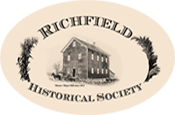Last 50 Years in the Mill House
by Linda Derrick
Fourth and final article in a series
The last 50 years in the Mill House -- The 1930s to the 1970s This is the fourth and final article about the families of the Mill House. Their stories began over 150 years ago when they left Germany to start a new life in America. They came to Richfield, built the saw mill and the grist mill, worked hard, raised families and prospered in their new homeland. This last article continues the life of the Mayer family from the 1930s to the 1970s.
The year is 1930. George and his brother Charles have been running the  Saw Mill and the Grist Mill since the death of their father 13 years earlier. But, in the past several years, the need for lumber and changing technology has impacted the lumber business. After more than 60 years of operation, it is no longer prosperous. George and Charles decide to cease operation. For many years their lumber cutting business served the community well; especially in the beginning when families were immigrating to the area needing lumber cut to build their homesteads. With the Saw Mill closed, just the Grist Mill remains.
Saw Mill and the Grist Mill since the death of their father 13 years earlier. But, in the past several years, the need for lumber and changing technology has impacted the lumber business. After more than 60 years of operation, it is no longer prosperous. George and Charles decide to cease operation. For many years their lumber cutting business served the community well; especially in the beginning when families were immigrating to the area needing lumber cut to build their homesteads. With the Saw Mill closed, just the Grist Mill remains.
1930 is also about the time that electricity comes to the Grist Mill and the Mill House. For close to 60 years oil lamps and candles were the only source of light in the Mill House. Now, all they had to do was press a button on the wall, and electric lights illuminate the room.
Two more years go by and Charles is now 33 years old. He was just a teenager when he partnered with his brother George in 1917 to operate  both mills. Now it’s 1932 and Charles decides it is time to sell his share of the Grist Mill to George. He marries and moves to Hartford. George is now the sole operator of the Grist Mill.
both mills. Now it’s 1932 and Charles decides it is time to sell his share of the Grist Mill to George. He marries and moves to Hartford. George is now the sole operator of the Grist Mill.
At this point there are five members of the Mayer family living in the Mill House: George’s mother (Mary Anne), George and his wife Martha, as well as their two children, Vern and Carol.
 For Carol and Vern, growing up in the Mill House during the 1930s and into the 1940s is a good childhood. Their summers are filled with warm days spent playing outdoors. They swim in the mill pond and play with the children who accompany their
For Carol and Vern, growing up in the Mill House during the 1930s and into the 1940s is a good childhood. Their summers are filled with warm days spent playing outdoors. They swim in the mill pond and play with the children who accompany their  fathers to process grain at the Grist Mill. School is just one mile away and an easy walk south through the fields and over the Cooney Creek to the corner of Highways 167 and 164. When school is over, they walk home the same way. But, the highlight of the walk home is when their father George meets them half way with the horse and wagon to give them a ride.
fathers to process grain at the Grist Mill. School is just one mile away and an easy walk south through the fields and over the Cooney Creek to the corner of Highways 167 and 164. When school is over, they walk home the same way. But, the highlight of the walk home is when their father George meets them half way with the horse and wagon to give them a ride.
Even the colder weather brings excitement for the children because soon it will be Christmas. December means cutting down a Christmas tree and putting it up in the parlor. The Christmas decorations come out, and  Grandma (Mary Anne) and Mother (Martha) are busy preparing for Christmas. This is when Grandma closes the parlor doors so the kids couldn’t see what she is doing. For young Carol, curiosity gets the best of her one day. She tries peeking through the key hole of the parlor door hoping to see what kind of presents Grandma is wrapping. Carol is caught spying, and the next time she tries sneaking a peek, she finds Grandma has stuffed cotton in the key hole.
Grandma (Mary Anne) and Mother (Martha) are busy preparing for Christmas. This is when Grandma closes the parlor doors so the kids couldn’t see what she is doing. For young Carol, curiosity gets the best of her one day. She tries peeking through the key hole of the parlor door hoping to see what kind of presents Grandma is wrapping. Carol is caught spying, and the next time she tries sneaking a peek, she finds Grandma has stuffed cotton in the key hole.
As winter progresses, the mornings get pretty cold even inside the house. When it is really cold outside, not much of the heat from the kitchen’s wood-burning cook stove reaches the bedrooms upstairs. Some winter mornings the temperature upstairs is in the 30s, and the children find it hard to climb out from under the warm feather-tick quilts that cover their beds.

 As Carol and Vern got older, it is expected that they help with chores. One of Carol’s chores is to make butter in the butter churn. She has to crank the handle again and again until the cream turns to butter. However, the sweet taste of fresh butter on Mom’s warm homemade bread makes it all worth the effort. Carol also helps with gardening, baking and canning. Vern helps with farm chores, cutting wood and butchering.
As Carol and Vern got older, it is expected that they help with chores. One of Carol’s chores is to make butter in the butter churn. She has to crank the handle again and again until the cream turns to butter. However, the sweet taste of fresh butter on Mom’s warm homemade bread makes it all worth the effort. Carol also helps with gardening, baking and canning. Vern helps with farm chores, cutting wood and butchering.
A new decade arrives, and the 1940s bring change. Vern is a young man, and he leaves home to join the Navy. The Grist Mill business is declining. Although it has been operated by electric motors for the past 10 years, modern technology is leading to more efficient and better ways to process the grain used for human consumption. The Grist Mill is now only grinding grain for cattle feed. With each year that passes, business keeps dropping.
and he leaves home to join the Navy. The Grist Mill business is declining. Although it has been operated by electric motors for the past 10 years, modern technology is leading to more efficient and better ways to process the grain used for human consumption. The Grist Mill is now only grinding grain for cattle feed. With each year that passes, business keeps dropping.
By the 1950s, the Grist Mill ceases operation. It stands silent forever for  the first time in almost 90 years. George closes the door to the Grist Mill for good, leaving all the equipment intact as is. George and Martha continue to live in the Mill House for the next several years. Vern is married and living in Florida, and Carol is also married and no longer living at home. In 1969 Martha dies, and George is now the only resident in the house for the next two years.
the first time in almost 90 years. George closes the door to the Grist Mill for good, leaving all the equipment intact as is. George and Martha continue to live in the Mill House for the next several years. Vern is married and living in Florida, and Carol is also married and no longer living at home. In 1969 Martha dies, and George is now the only resident in the house for the next two years.
In 1971, George goes to live with his daughter Carol and her family. In 1973, he dies at the age of 83. He is the last of the Mill Operators who lived, prospered and raised his family in the Mill House. He has lived a long and successful life. He has left a legacy that is remembered and shared as an important part of Wisconsin’s history.
Footnote: Today we are very fortunate that this history lives on. Thanks to the Town of Richfield (aka the Village of Richfield), the Richfield Historical Society, its many dedicated and hardworking volunteers and the descendents of the Messer and Mayer families, the history of the Grist Mill and the Mill House have been restored and preserved for all to enjoy. RHS Newsletter – Living in the Mill House from the 1930s to 1970s (Spring 2018 newsletter) George Mayer in later years sitting in the Mill House kitchen next to the wood-burning cook stove.
If you missed reading the first three articles in this series, you can find them in past RHS newsletters:
1 -- December 2016 Newsletter: "A Journey to Richfield" which told the story of Andrew Messer who built the Mill House.
2 – April 2017 Newsletter: "Making a Life in America" which continued the story, including the next family to live in the Mill House; i.e., the Mayers.
3 – August 2017 Newsletter: "Living into the 20th Century" which followed the Mayers' as they lived and prospered into the new century.
Hope you enjoyed this story
Enjoy our other stories

